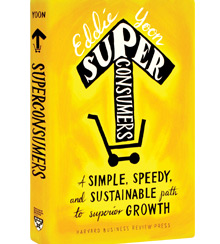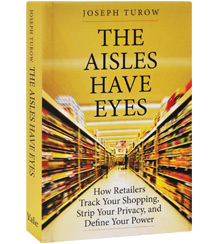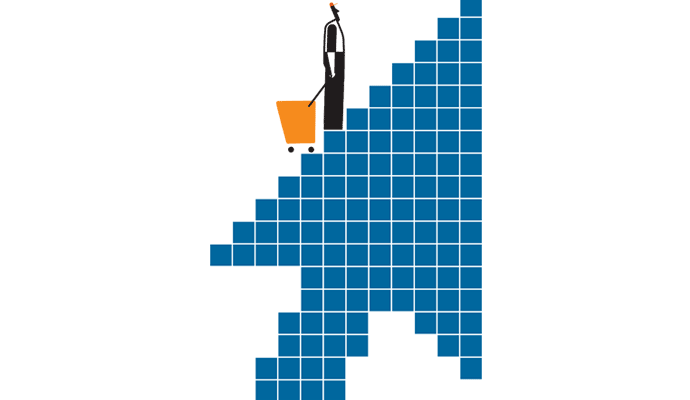Best Business Books 2017: Marketing
Steady Progress
Eddie Yoon
Superconsumers: A Simple, Speedy, and Sustainable Path to Superior Growth (Harvard Business Review Press, 2016)
*A TOP SHELF PICK
Joseph Turow
The Aisles Have Eyes: How Retailers Track Your Shopping, Strip Your Privacy, and Define Your Power (Yale University Press, 2017)
Thomas A. Stewart and Patricia O’Connell
Woo, Wow, and Win: Service Design, Strategy, and the Art of Customer Delight (HarperCollins, 2016)
Smartphones are proliferating! People — especially millennials — are cutting the cable cord in favor of buying their media à la carte! The rise of programmatic ad buying is allowing marketers to target at the micro level across devices!
With all the chaos in marketing, technology, and media, 2017’s crop of marketing books, many of which covered such topics, seemed thoroughly expected. I’d venture that as shape-shifting as marketing has had to become — who, really, watches much network TV anymore? Or clicks on banner ads? — it has also, strangely, reached a point of stasis. The megatrends affecting the field have become as accepted in the business as cable TV became by the late 1980s.
It’s not that there’s nothing left to learn. Rather, what we’re seeing now, reflected in this year’s best business books on marketing, is the triumph of incrementalism. Instead of reinventing the wheel, marketers need to expand their competencies, even against the steady drumbeat of technological change.
The year’s best offering was Superconsumers: A Simple, Speedy, and Sustainable Path to Superior Growth, by Eddie Yoon. A confession: I originally reviewed this book for the Spring 2017 issue of s+b. But its inclusion here can’t be chalked up to that bane of modern marketers, a short attention span. What I discovered was that after I had carefully vetted more than a dozen additional books for this review, Superconsumers continued to stay with me for its brevity, its anthropological approach, and its power. The book contains compelling examples of what makes the people of the title — the small minority of customers who buy more of, and have a concurrent passion for, a particular product — so vital for building businesses. It was also hands down the most enjoyable read.
Yoon, growth strategist at Eddie Would Grow, introduces readers to people like Laura, a superconsumer of Nacho Cheese (a real product given a generic name). In a meeting with the brand team, she demonstrates an attribute of the product that its marketers might not have noticed. While dipping a piece of broccoli into melted Nacho Cheese, “she pointed out how the cheese was viscous enough to form a perfect crown on the broccoli’s head without falling off the side, yet melty enough to fill every crack and crevice.”
Then there’s Sally, who has a passion for office products. In many writers’ hands, Sally would be a ripe subject for ridicule. But Yoon deftly explains why such prosaic products as three-ring binders and staplers inspire legitimate passion in some people: These products are “hired” to do a job beyond their baseline function. Sally, who works at a car rental agency, “hires” office products to bring a sense of calm to a tumultuous workplace. That three-ring binder is a portal to control. It’s “like a trophy for a job well done and her way of bringing order to the chaos.”
Instead of reinventing the wheel, marketers need to expand their competencies.
For many marketers, Superconsumers will prove illuminating because it emphasizes that you don’t have to be a maker of cutting-edge basketball shoes or fast cars to inspire passion. The key, says Yoon, is to uncover the larger reason that superconsumers are hiring your product, and use those insights to expand your market. “Superconsumers are not the be-all and end-all,” explains Yoon. “But they are the proper place to start a consumer-centric strategy.”
Yoon also points out that the lessons marketers glean from superconsumers can rope in even larger audiences and thus have a broader business impact. In an anecdote about the champagne category, Yoon explains that women superconsumers in particular “hire” the bubbly wine in the summer, as an alternative to beer. Because that context is different than it is during celebrations — when a number of people might share a bottle — the industry began producing single-serving champagne bottles.
While delighting superconsumers, this new way of packaging champagne raised the “fun” ratio because consumers could try a variety and no longer had to worry about wasting champagne. This has helped make champagne more attractive to potential superconsumers, expanding its appeal.
TMI?
Attend virtually any marketing conference, and you’ll sense great excitement in the room when discussion turns to the potential of data to help marketers understand consumers at an unprecedented level. What’s rarely acknowledged, however, is that there’s also something Orwellian about a world in which marketers and retailers can track user locations, transactions, and passions in real time. Is the mobile age helping consumers and products discover one another? Or is it creating an environment of constant surveillance?
Because it wrestles intelligently with these issues, I chose The Aisles Have Eyes: How Retailers Track Your Shopping, Strip Your Privacy, and Define Your Power as another of this year’s best business books on marketing. It’s a skeptical — even occasionally paranoid — view of how big data is changing the face of retailing and, at some level, reordering the way people relate to one another. As such, it pushes marketers to step out of their industry bubble and consider an alternative viewpoint from an academic. “The transformation of retailing is, at the core, a rethinking of the ways merchant–customer relationships should take place in the twenty-first century,” writes Joseph Turow, the Robert Lewis Shayon Professor of Communication and associate dean for graduate studies at the Annenberg School for Communication at the University of Pennsylvania. “Monitoring and discrimination are certainly critical to this rethinking, but they are only part of an accelerating project to redefine relationships with shoppers.” By marrying loyalty programs to tracking devices and the smart manipulation of images and messages, he argues, retailers are pushing shoppers to “accept systematic biases about them.”
That’s loaded language. The end game, per Turow, is that retailing will return to being discriminatory, as digital technology gives retailers the ability to dynamically change pricing based on individual customer data. An affluent and loyal customer may get a lower price on high-end skincare products than someone who is less loyal. A new customer who holds potential for cross-selling — perhaps she’s a grandparent who could be persuaded to buy more accessories for her granddaughter’s American Girl dolls — may get a better price than someone perceived as not having additional value, and so forth. To a degree, if this happens, it will be going back to the past. In the 19th century, when retailer–customer relationships were more intensely personal, “selling techniques centered around prejudice and discrimination, with peddlers and small merchants determining which shoppers were ‘winners’ and which were ‘losers’ in the course of negotiating sales based on such measures as the purchaser’s race, gender, ethnicity, and income,” Turow writes.
Its dire warnings aside, the book packs a punch because it provides an exhaustively researched look at the history of retailing. Most of us don’t really know how UPC codes got their start (they solved the problem of telling grocery stores when it was time to restock by transmitting sales data instantly to headquarters), or have forgotten that in the pre-industrial economy, most pricing was really the result of haggling.
Turow certainly paints a detailed and accurate picture of how the future he envisions — and fears — is technologically possible. It is not hard to see how stores could deploy the big data they hoover up to target shoppers with customized coupons and enticements. Turow notes that this already happens in the airline industry, where frequent fliers receive more perks than occasional customers and pricing is dynamic. It could be that the passenger seated next to you paid twice as much, or half, or nothing at all, for his or her ticket.
But the book misses by giving short shrift to consumers’ power and agency. As norms surrounding privacy and sharing have changed, there’s much to suggest that when it comes to privacy, consumers aren’t putting their money where their mouth is. Even though they express concern about how their data is used, they continue to shop at e-tailers such as Amazon, which use individual purchase behavior to spur additional transactions. And a 2014 Pew Research Center study found that only half of respondents thought their physical location over time was “very sensitive” and a mere 8 percent thought their basic shopping habits were “very sensitive.”
What’s more, if we’ve learned anything in the last decade of social media proliferation, it’s that consumers will speak up — loudly, and on multiple platforms — when they feel a company is mistreating them. Although Turow asserts that consumers won’t know when the marketplace is discriminating against them, it doesn’t take much crowdsourcing to uncover truly abhorrent behavior by retailers. It’s true that companies know where to find consumers and how to push their levers; however, as anybody who works on social media for airlines will tell you, consumers know where to find companies, too.
That said, The Aisles Have Eyes should be regarded as a wakeup call. Turow’s dark vision may never come to pass. But it’s worth thinking about how the powerful forces and tools already in place could make a discriminatory marketplace an unpleasant reality.
Winning Design
Woo, Wow, and Win: Service Design, Strategy, and the Art of Customer Delight provides a bracing counterbalance to The Aisles Have Eyes. Its authors, Thomas A. Stewart, director of the National Center for the Middle Market at Ohio State University (and a byline familiar to readers of s+b), and Patricia O’Connell, president of Aerten Consulting, put the voice of the customer front and center. Rather than viewing a customer as a mark to be manipulated or a source of data, Stewart and O’Connell regard each customer as “an active, and quite possibly idiosyncratic, participant in the creation of value.”
The concept of “service design” essentially describes the components and strategies companies put in place to attract and keep customers. “The experience of customers propels forward your work to improve the experience of customers — customer feedback becomes customer feed-forward — and you are measuring both the input and the output,” they write.
Indeed, Woo, Wow, and Win is what might be called a post-marketing book. It views the act of winning over customers not as a series of tag lines and media buys leading to purchases, but as a set of customer experiences, which, when handled appropriately, can drive business forward.
A brand such as Dunkin’ Donuts, as the book emphasizes, is all about service design. It knows its customers are on the go and builds everything around that truth, by operating drive-through stores, picking quick-serve menu items, serving some food in cupholder-sized containers, and developing an on-message tag line (“America Runs on Dunkin’”). By providing caffeine, sugar, carbs, and protein, the brand literally fuels its customers’ journeys.
Good service design can help companies define who their optimal customers are — and who their suboptimal customers are. Your company can “arrange the links of your value chain to capture and encourage the customers you want, while siphoning away customers whom you cannot serve profitably or well,” the authors write.
Indeed, as that quote makes clear, one strength of the book is its willingness to eschew marketing orthodoxy. In fact, the first of its five service design principles is “The Customer Is Always Right — Provided the Customer Is Right for You.” In short, there’s no business sense in bending over backward for a customer who’s not a fit for what you’re selling.
These guardrails are important. It would be too easy to view service design as trying to please all customers all the time. In fact, there’s a full chapter devoted to what the book calls service design archetypes, from “classic” brands such as Verizon Wireless to “trendsetter” brands such as Warby Parker. Service design changes according to brand type. Those who shop at Costco, listed under the archetype “the bargain,” should not expect the store to stock five different brands of mayonnaise in eight-ounce bottles, or even to give them plastic bags to carry it home in. Costco’s service design needs to hew to what it is: a place to buy large quantities of a limited variety of goods cheaply and conveniently.
The authors also throw cold water on the belief that marketers need to “surprise and delight” customers. Delight them, sure. But if servicing a customer requires behind-the-scenes heroics, then the service design is out of alignment.
One last thing. Even though it’s easy to think service design applies more to services than products, Woo, Wow, and Win does an exceptional job of explaining why many products have become product–service hybrids. One reason people buy computers from Apple or boots from L.L. Bean is that they know those companies will be there for them if something goes wrong.
This year’s best business books on marketing may not appear to have much in common. Superconsumers and Woo, Wow, and Win have entirely different views of the consumer in comparison with The Aisles Have Eyes. But one common theme courses through these enjoyable books. The challenge isn’t to understand how technology changes the relationship between people who sell things and people who buy things. We all seem to get that. Rather, the task is to figure out the contours, shape, and rules of the future marketplace.
Reprint No. 17414
Author profile:
- Catharine P. Taylor has covered digital media since 1994, writing for publications including Adweek and Advertising Age. She also wrote the weekly Social Media Insider column for MediaPost for seven years, and is a program director for the Conference Board, managing some of its marketing-focused events.








